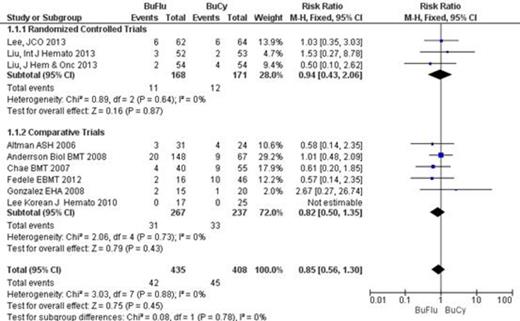Abstract

Background: Both busulfan-cyclophosphamide (BuCy) and the reduced toxicity regimen busulfan-fludarabine (BuFlu) are considered myeloablative preparative regimens given prior to allogeneic hematopoietic cell transplantation (HCT). A comprehensive literature evaluation of BuFlu vs. BuCy is lacking and the question of the preferable regimen is still debatable.
Objectives: We aimed to compare the efficacy and safety of BuFlu (intervention arm) vs. BuCy (comparable arm) as preparative regimens in patients given allografts.
Methods: Systematic review and meta-analysis of all randomized controlled trials (RCTs) and non-randomized comparative trials of patients given BuFlu vs. BuCy as preparative regimens prior to allografts. Electronic search in the Cochrane Library, MEDLINE and conference proceedings was conducted up-to July 2014. Primary outcomes were all-cause mortality at 100 days and at the end of study. Secondary outcomes were time to neutrophil engraftment, primary & secondary rejection, risk for grade 3-4 mucositis, sinusoidal obstruction syndrome (SOS), microbiology documented infection, overall and grade 3-4 acute graft vs. host disease (GVHD), overall and extensive chronic GVHD, non-relapse mortality at 100 day and at the end of study, and relapse risk. For dichotomous data, relative risks (RR) with 95% confidence intervals (CIs) were estimated and pooled. For continuous variables we calculated weighted mean difference (WMD).
Results: Our search yielded 14 trials recruiting 1578 patients. Three trials were RCTs and 11 were either one arm intervention trials compared to historical controls or retrospective studies. There were no differences in all-cause mortality at 100 days and end of study ( RR 0.85; 95% CI 0.56-1.30, 9 trials and RR 0.77; 95% CI 0.59-1.02, 12 trials, respectively), Figure, with similar results in sensitivity analyses including only RCTs and only studies in which patients' age and status of disease at HCT were well matched. Both primary and secondary rejections were comparable between the two regimens. Time to neutrophil engraftment was 1-day longer in patients given the BuCy regimen (WMD 0.84; 95% CI 0.37-1.31, 6 trials). Both the risks for SOS and microbiology documented infections were lower in the BuFlu patients (RR 0.34; 95% CI 0.19-0.62, 8 trials and RR 0.79; 95% CI 0.64-0.97, 2 trials, respectively). Grade 3-4 mucositis was comparable between the two groups. There was a lower incidence of grade 2-4 acute GVHD in patients given FluBu (RR 0.67; 95% CI 0.46-0.99, 10 trials), however this was no longer true in sensitivity analysis including only RCTs. There were no differences between the two arms in grade 3-4 acute GVHD, overall and extensive chronic GVHD, non-relapse mortality at 100 days and at the end of study and relapse risk.
Conclusions: While toxicity profile of BuFlu regimen is safer than the classic BuCy regimen, this does not translate into composite transplantation outcomes. Patients at higher risk for SOS may benefit from the BuFlu regimen; however additional RCTs are required to identify other subgroups of patients who will benefit from a tailored-preparative regimen approach.
No relevant conflicts of interest to declare.
Author notes
Asterisk with author names denotes non-ASH members.

This icon denotes a clinically relevant abstract


This feature is available to Subscribers Only
Sign In or Create an Account Close Modal